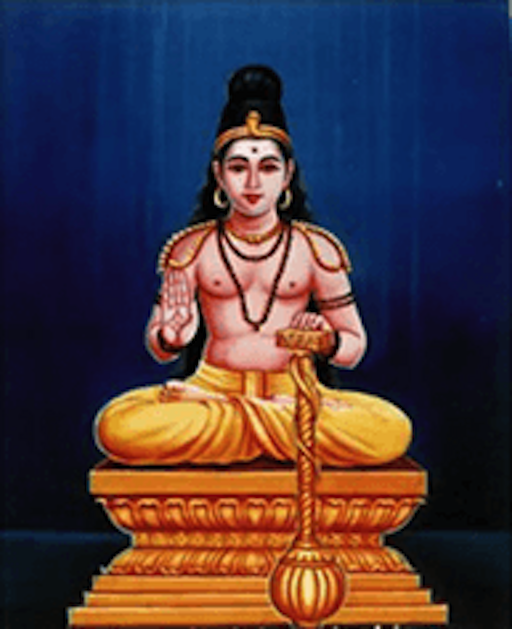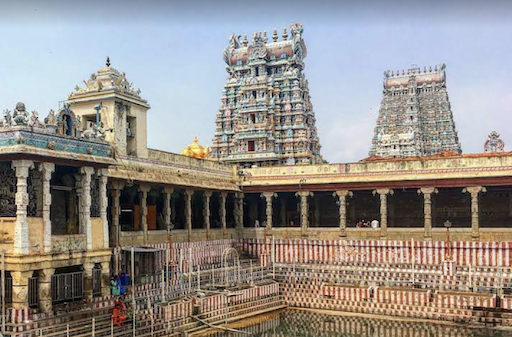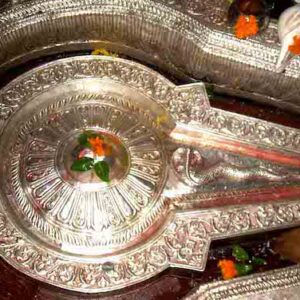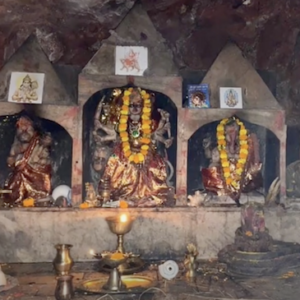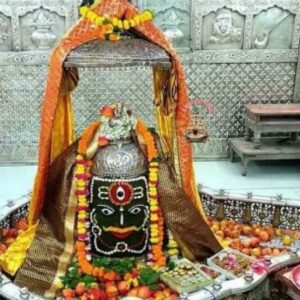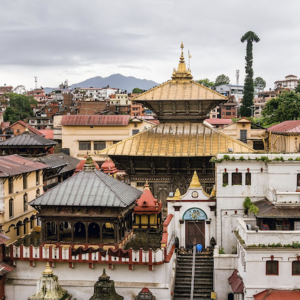This is a Jeevasamadhi of Sundaranandar Siddhar, one of revered 18 Siddhars from Tamil Nadu. The Jeevasamadhi is inside the Meenakshi Amman Temple. The Jeevasamadhi is located on the south left corner of the inner complex towards the left of Mukkuruni Vinayagar Ganesh. Note that there was no label to indicate it is Jeevasamadhi. The Jeevasamadhi lies beyond the barricade. However, there is a place to sit and meditate next to the Jeevasamadhi. You can go into meditative states here effortlessly.
How to get there
Meenakshi Amman temple lies in the center of the Madurai, and 11 kms north of Madurai Airport.
Map: https://goo.gl/maps/sCjA8eAmECdKSp4DA
About Sundaranandar Siddhar
Sundaraanandar Siddhar is the disciple of Sattaimuni Siddhar, whose life and select works were presented in the previous edition of Siddhar Charithiram. There are not many references about the pre-siddhi life of Sundaraanandar Siddhar. The text of “Bogar 7000” by one among the great Pathinen Siddhargal – Bogar has a few references about Sundaraanandar Siddhar. There is a reference that Sundaraanandar Siddhar was the grandson of Rishi Navakanta from the Kishkintha hills. Siddha Sundaraanandar is also considered to be an expert in space travel, samadhi and Khecari Yoga.
Legend has it that, the great Siddha and Sage Agastya Muni, presented a lingam he worshipped to Sundaraanandar Siddhar. From then on, Sundaraanandar worshiped this lingam and performed pooja everyday. The book “The Yoga of Eighteen Siddhas: An Anthology” describes a beautiful incident. It so happened that Lord Shivaperuman took the form of a Siddha and met Sundaraanandar Siddhar and asked him to explain that particular lingam he had. Siddha Sundaraanandar explained that there are two major types of lingam – Parartha-lingam and Ishta -lingam. Parartha-lingam is further classified into five: Swayambu-lingam – one which appeared by itself; Gana-lingam – one created by Lord Shivaperuman’s attendants Ganas; Daivika-lingam – one created by divine beings; Arsha-lingam – created by the Rishis and Manusya-lingam created by human beings.
Ishta-lingam is created for the personal use of a specific person and one who possesses such a linga does not eat anything until worship of the linga is performed everyday. Sundaraanandar Siddhar explains to the Visitor that the one he possesses happens to be an Ishta-lingam and an Arsha-lingam having been created by the great Agastyamuni. As per Agastyamuni’s guidance, he performs pooja everyday. “As I see the Lord everywhere, I see Him in the lingam also. Like fire resides in a stick, I see the all-pervasive Lord in the lingam and worship everyday.”
Sundaraanandar Siddhar lived with his guru Sattaimuni Siddhar in the Thavasi Parai caves in the Saduragiri Mountains. He later established the Sundaramahalingam in the Thaniparai area of Saptur reserve forests in Tamilnadu. The mountain shrine is considered a dwelling place of many siddhars. One can also find numerous medicinal plants growing in the Saduragiri Mountains.
While living in the Sathuragiri hills, it is said that Sundaraanandar Siddhar compiled various works on Siddha medicine and astrology. Sundaraanandar Siddhar in his works of astrology has provided means to appropriate general predictions on the day of birth, day of attaining puberty etc. In another work it is said that, Sundaraanandar Siddhar has provided auspicious days for cultivating mango, coconut, banana, sugarcane, lentils and other crops for a fertile yield. Manaiyadi Saasthiram given by Sundaraanandar Siddhar guides in appropriate ways to construct houses that lead to healthy life of the occupants. Sundaraanandar Siddhar works on poison treatment and preparation of medicinal salt muppu are also hailed in the Siddha medicine system. Koodal at Madurai is considered as the samadhi sthala of Sundaraanandar Siddhar. In this edition we are blessed to present a few gems from the literary works of Sundaraanandar Siddhar.
Like his predecessors and his successors, Sundaraanandar paadalgal touched many dimensions. Some of the Sundaraanandar paadalgal contains beautiful anecdotes on That, Parampoorul, the power of Silence, etc., which is as unique expression as the Siddha’s work.
Read More
https://www.anaadifoundation.org/blog/parnika/siddhar-charithiram-sundaraanandar-siddhar/
